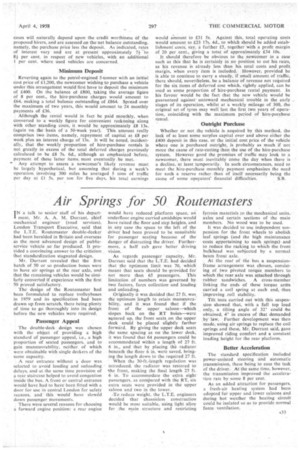Air Springs for 50 Routemasters
Page 75

If you've noticed an error in this article please click here to report it so we can fix it.
IN a talk to senior staff of his depart.' ment, Mr. A. A. M. Durrant, chief mechanical engineer (road services), London Transport Executive, said that the L.T.E. Routernaster double-decker had been heralded in Britain and overseas as the most advanced design of publicservice vehicle so far produced_ It proyided a convincing answer to the criticism that standardization stagnated design.
Mr. Durrant revealed that the first batch of 50 or so production buses were to have air springs at the rear axle, and that the remaining vehicles would be similarly converted if experience with the first 50 proved satisfactory.
The design of the Routemaster had been formulated to replace trolleybuses in 1959 and its specification had been drawn up from scratch, there being plenty of time to go thoroughly into its design before the new vehicles were required.
Passenger Appeal The double-deck design was chosen with the object of providing. a high standard of passenger appeal, i.e., a high proportion of seated passengers, and to gain manceuvrability, neither of which were obtainable with single deckers of the same capacity.
A rear entrance without a door was selected to avoid loading and unloading delays, and at the same time provision of a rear staircase helped to avoid congestion inside the bus. A front or central entrance would have had to have been fitted with a door for use in central London for safety reasons, and this would have slowed down passenger Movements.
. There were several reasons for choosing a forward engine position: a rear engine would have reduced platform space, an underfloor engine carried amidships would have raised the floor and step heights, and in any case the space to the left of the driver had been proved to be unsuitable for passenger seating because of the danger of distracting the driver. Furthermore, a half cab gave better driving vision.
As regards passenger capacity, Mr. Durrant said that the L.T.E. had decided that the Optimum limit was 70, which meant that seats should be -provided for not more than 65 passengers. This limitation of numbers was governed by two factors, fares collection: and loading and unloading_
Originally it was decided that 27 ft. was. the optimum length to retain manoeuvrability, and it was found that if the front of the upper saloon—which slopes back on the RT buies—were squared up, the front seats on the upper deck could be placed slightly farther forward. By giving the upper deck seats the same spacing as on the lower deck, it was found that 64 passengers could be accommodated within a length of 27 ft. 6 in., and that by placing the radiator beneath the floor 6 in. were saved, bringing the length down to the required 27 ft.
When the 30-ft.-length regulation was introduced, the radiator was restored to the front, making the final length 27 ft_ 6 in. To accommodate the extra eight passengers, as compared with the RT, six extra seats were provided in the upper saloon and two in the lower.
-To reduce weight, the L.T.E. engineers decided that chassisless construction would be most suitable, using light alloy for the main structure and restricting ferrous materials to the mechanical units. axles and certain sections of the main members. No wood was to be used.
It was decided to use independent suspension for the front wheels to abolish leaf springs (and the high maintenance costs appertaining to such springs) and to reduce the racking to which the front bulkhead was subjected by a normal beam front axle.
At the rear of the bus a suspensionframe arrangement was chosen, consisting of two pivoted torque members to which the rear axle was attached through rubber sandwiches. A cross-member linking the ends of these torque arms carried a coil spring at each end, thus improving roll stability.
Tilt tests carried out with this suspension showed that, with a full top load only, a tilting angle of 32° could be obtained, 4° in excess of that demanded by law. Further development was then made, using air .springs to replace the coil springs and these, Mr. Durrant said, gave improved riding comfort and a constant loading height for the rear, platform.
Better Acceleration
The standard specification included power-assisted steering and automatic transmission, these being to ease the task of the driver. At the same time, however, the transmission improved the acceleration rate by some 8 per cent.
As an added attraction for passengers, a fresh-air heating system had been adopted for upper and lower saloons and during hot weather the heating circuit could be isolated so as to provide normal force ventilation.












































































































